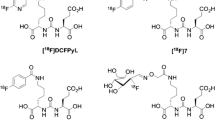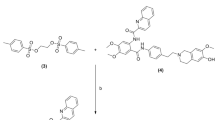Abstract
Purpose
The p-glycoprotein (Pgp) is the most prominent member of active drug transporters leading to a multidrug-resistant phenotype. For identification of tumors functionally overexpressing Pgp in vivo, non-invasive imaging techniques are needed.
Procedures
Six Schiff base compounds were synthesized and labeled with 68Ge/68Ga generator-derived 68Ga. The compounds were studied in vitro in Pgp-positive tumor cells. The property of being a Pgp substrate was tested by comparison of the tracers uptake in R-3327 Dunning prostate carcinoma AT1 cells in presence and absence of the Pgp-inhibitor verapamil. In vivo investigations were performed with tumor-bearing rats imaged with micro-positron emission tomography.
Results
All ligands were labeled with 68Ga in yields of >92% beside one (~55%). The tracers showed different accumulation within the cells in vitro (4–60%). In blocking experiments, the ratio (blocked to unblocked) varied from 1.8 to 1.0. For in vivo experiments, 68Ga–ENBDMPI and 68Ga–MFL6.MZ were selected. The tumors showed specific uptake of the tracer. Direct intratumoral injection of verapamil increased the tracer concentration by ~25% reflecting the functional Pgp activity.
Conclusions
Two 68Ga-labeled ligands appear to be valuable for imaging non-invasively the intratumoral Pgp activity. On a long term, patients with multidrug-resistant tumors pre-therapeutically may be identified prior to treatment.











Similar content being viewed by others
Abbreviations
- Pgp:
-
p-glycoprotein
- VPL:
-
verapamil
- MDR:
-
multidrug resistance
References
Schinkel AH, Jonker JW (2003) Mammalian drug efflux transporters of the ATP binding cassette (ABC) family: an overview. Adv Drug Deliv Rev 55:3–29
Higgins CF (2001) ABC transporters: physiology, structure and mechanism—an overview. Res Microbiol 152:205–210
Chang G (2003) Multidrug resistance ABC transporters. FEBS Lett 555:102–105
Fojo T, Bates S (2003) Strategies for reversing drug resistance. Oncogene 22:7512–7523
Hendrikse NH, Franssen EJ, van der Graaf WT, Vaalburg W, de Vries EG (1999) Visualization of multidrug resistance in vivo. Eur J Nucl Med 26:283–293
Liu Z, Stevenson GD, Barrett HH, Kastis GA, Bettan M, Furenlid LR et al (2004) Imaging recognition of multidrug resistance in human breast tumors using 99mTc-labeled monocationic agents and a high-resolution stationary SPECT system. Nucl Med Biol 31:53–65
Kurdziel KA, Kalen JD, Hirsch JI, Wilson JD, Agarwal R, Barrett D et al (2007) Imaging multidrug resistance with 4-[18F]fluoropaclitaxel. Nucl Med Biol 34:823–831
Vaalburg W, Hendrikse NH, Elsinga PH, Bart J, Van WA (2005) P-glycoprotein activity and biological response. Toxicol Appl Pharmacol 207:257–260
Hsiao P, Sasongko L, Link JM, Mankoff DA, Muzi M, Collier AC et al (2006) Verapamil P-glycoprotein transport across the rat blood-brain barrier: cyclosporine, a concentration inhibition analysis, and comparison with human data. J Pharmacol Exp Ther 317:704–710
Zhernosekov KP, Filosofov DV, Baum RP, Aschoff P, Bihl H, Razbash AA et al (2007) Processing of generator-produced 68Ga for medical application. J Nucl Med 48:1741–1748
Asti M, De Pietri G, Fraternali A, Grassi E, Sghedoni R, Fioroni F et al (2008) Validation of 68Ge/68Ga generator processing by chemical purification for routine clinical application of 68Ga-DOTATOC. Nucl Med Biol 35:721–724
Sharma V, Beatty A, Wey SP, Dahlheimer J, Pica CM, Crankshaw CL et al (2000) Novel gallium(III) complexes transported by MDR1 P-glycoprotein: potential PET imaging agents for probing P-glycoprotein-mediated transport activity in vivo. Chem Biol 7:335–343
Sharma V, Prior JL, Belinsky MG, Kruh GD, Piwnica-Worms D (2005) Characterization of a 67Ga/68Ga radiopharmaceutical for SPECT and PET of MDR1 P-glycoprotein transport activity in vivo: validation in multidrug-resistant tumors and at the blood–brain barrier. J Nucl Med 46:354–364
Thews O, Gassner B, Kelleher DK, Schwerdt G, Gekle M (2006) Impact of extracellular acidity on the activity of p-glycoprotein and the cytotoxicity of chemotherapeutic drugs. Neoplasia 8:143–152
Workman P, Twentyman P, Balkwill F, Balmain A, Chaplin DJ, Double JA et al (1998) United Kingdom Co-ordinating Committee on Cancer Research (UKCCCR) Guidelines for the Welfare of Animals in Experimental Neoplasia (2nd edit.). Br J Cancer 77:1–10
Kunikane H, Zalupski MM, Ramachandran C, Kuruga MA, Lucas D, Ryan JR et al (1997) Flow cytometric analysis of p-glycoprotein expression and drug efflux in human soft tissue and bone sarcomas. Cytometry 30:197–203
Hendrikse NH, de Vries EG, Eriks-Fluks L, van der Graaf WT, Hospers GA, Willemsen AT et al (1999) A new in vivo method to study P-glycoprotein transport in tumors and the blood–brain barrier. Cancer Res 59:2411–2416
Syvänen S, Blomquist G, Sprycha M, Höglund AU, Roman M, Eriksson O et al (2006) Duration and degree of cyclosporin induced P-glycoprotein inhibition in the rat blood–brain barrier can be studied with PET. Neuroimage 32:1134–1141
Wang JH, Scollard DA, Teng S, Reilly RM, Piquette-Miller M (2005) Detection of P-glycoprotein activity in endotoxemic rats by 99mTc-sestamibi imaging. J Nucl Med 46:1537–1545
Xu RH, Pelicano H, Zhou Y, Carew JS, Feng L, Bhalla KN, Keating MJ, Huang P (2005) Inhibition of glycolysis in cancer cells: a novel strategy to overcome drug resistance associated with mitochondrial respiratory defect and hypoxia. Cancer Res 65:613–621
Trach P, Afahaene N, Nowak M, Thews O (2008) Impact of environmental parameters on the activity of the p-glycoprotein. Acta Physiol 192(suppl 663):107
Bigott HM, Prior JL, Piwnica-Worms DR, Welch MJ (2005) Imaging multidrug resistance P-glycoprotein transport function using microPET with technetium-99 m-sestamibi. Mol Imaging 4:30–39
Marian T, Szabo G, Goda K, Nagy H, Szincsak N, Juhasz I et al (2003) In vivo and in vitro multitracer analyses of P-glycoprotein expression-related multidrug resistance. Eur J Nucl Med Mol Imaging 30:1147–1154
Sauvant C, Nowak M, Wirth C, Schneider B, Riemann A, Gekle M et al (2008) Acidosis induces multi-drug resistance in rat prostate cancer cells (AT1) in vitro and in vivo by increasing the activity of the p-glycoprotein via activation of p38. Int J Cancer 123:2532–2542
Acknowledgments
The study was supported by the European Union (project COST D38 and BM0607) and the Deutsche Krebshilfe (grant 109136).
Conflict of Interest Disclosure
The authors declare that they have no conflict of interest.
Author information
Authors and Affiliations
Corresponding author
Rights and permissions
About this article
Cite this article
Fellner, M., Dillenburg, W., Buchholz, HG. et al. Assessing p-Glycoprotein (Pgp) Activity In Vivo Utilizing 68Ga–Schiff Base Complexes. Mol Imaging Biol 13, 985–994 (2011). https://doi.org/10.1007/s11307-010-0410-1
Published:
Issue Date:
DOI: https://doi.org/10.1007/s11307-010-0410-1




